ESP MERCEDES-BENZ SPRINTER 2019 MY19 with no MMS Operator’s Manual
[x] Cancel search | Manufacturer: MERCEDES-BENZ, Model Year: 2019, Model line: SPRINTER, Model: MERCEDES-BENZ SPRINTER 2019Pages: 322, PDF Size: 5.91 MB
Page 101 of 322
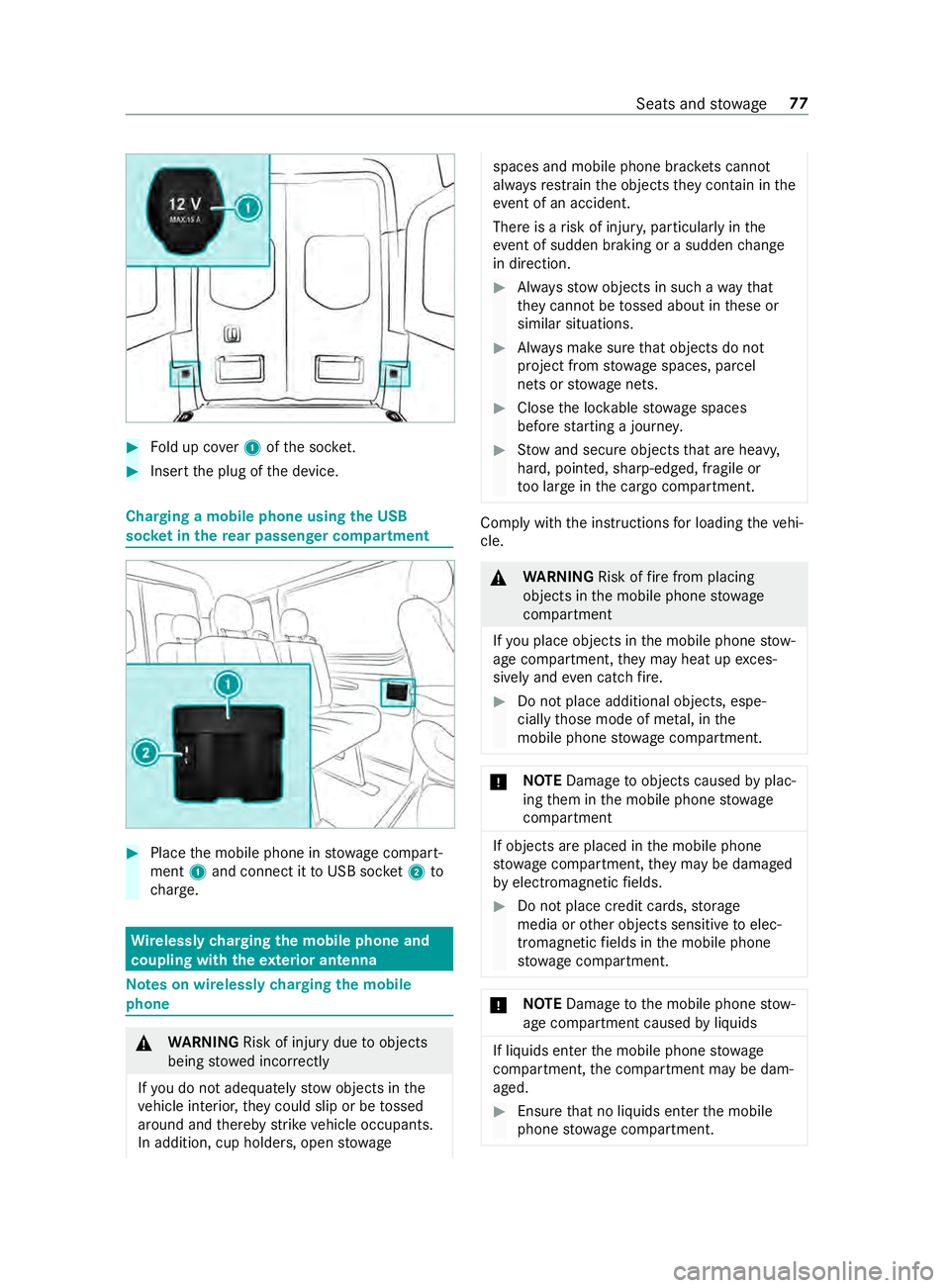
#
Fold up co ver1ofthes ocket. #
Inse rtthep lug of thed evice. Charging
amobile phone using theU SB
soc ketint he rear passen gerc om partment #
Place them obile phone in stowagec ompart‐
ment 1and connec tittoUSB socket2to
ch arge. Wire
lesslycharging them obil ephone and
coupling with thee xterior antenna Note
sonw irelessl ycharging them obile
phone &
WARNING Risk of inju rydue toobjects
being stowedincor rectly
If yo udon otadequatel ystowo bjectsint he
ve hicle interior ,the yc ould sli porbet ossed
around and thereb ystrik evehicle occupants.
In addition, cup holders, open stowage spaces and mobile phon
ebrack etsc annot
al wa ys restra in theo bject stheyc ontai nint he
eve nt of an accident.
The reisar isk of injur y,particular lyin the
eve nt of sudden braking or asudde nchange
in direction. #
Alwayss towo bjectsins uchaw aythat
th ey canno tbetossed about in these or
similar situations. #
Alwaysm akes uret hat objects do not
project from stowages paces, parcel
nets or stowagen ets. #
Close thel oc kable stow ages paces
befor estarti ngajou rney. #
Stow and secur eobject sthat ar eheavy,
hard, poin ted, sharp-edged, fragile or
to ol arge inthec argo compartment. Compl
ywitht he instructions forl oading thev ehi‐
cle. &
WARNING Risk offire from placing
objects in them obile phone stowage
compartment
If yo up laceo bject sinthe mobile phone stow‐
ag ec ompartment ,the ym ayheat up exces‐
sivel yand even catc hfire. #
Do no tplace additional objects ,espe‐
cially those mode of me tal, in the
mobil ephone stowagec ompartment. *
NO
TEDama getoobject scaused byplac‐
ing them in them obile phone stowage
compartment If object
sareplace dinthe mobile phone
stow agec ompartment ,the ym aybe dama ged
by electromagnetic fields. #
Do no tplace credit cards, storage
media or other objects sensitiv etoelec‐
tromagnetic fields in them obile phone
stow agec ompartment. *
NO
TEDama getothem obile phone stow‐
ag ec ompartment cause dbyliquids If liquids enter
them obile phone stowage
compartment ,the compartment ma ybedam‐
aged. #
Ensur ethat no liquids enter them obile
phone stowagec ompartment. Seat
sand stow age 77
Page 103 of 322
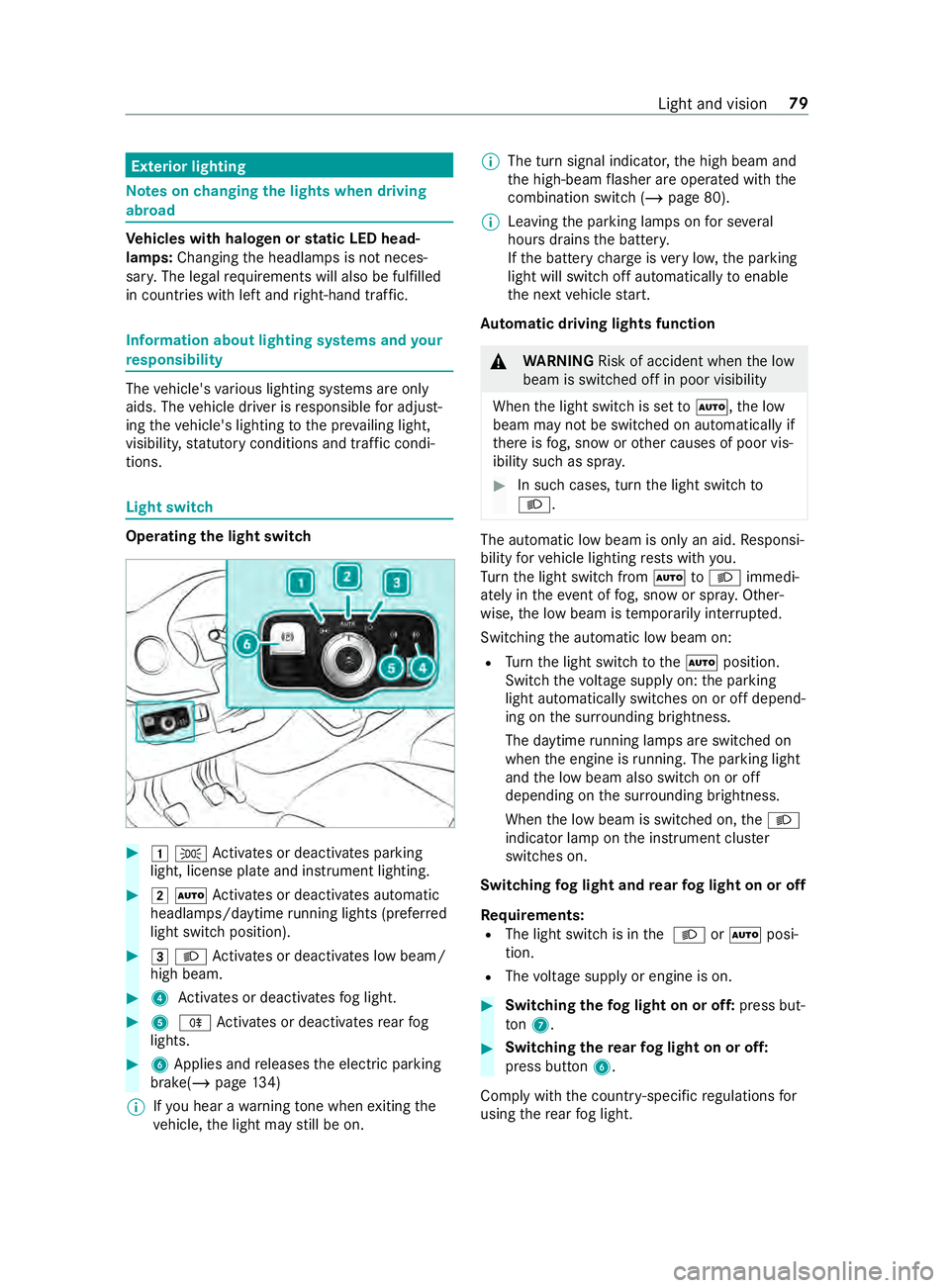
Exterior lighting
Note
sonc hanging thel ight swhen driving
abroad Ve
hicles with halogen or static LED head‐
lamps: Changing theh eadlamps is no tneces‐
sar y.The legal requ irements will also be fulfilled
in countries wit hlefta nd right-han dtraffic. Informatio
nabout lighting sy stems and your
re sponsibility The
vehicle's various lighting sy stems ar eonly
aids. The vehicle driver is responsible fora djust‐
ing thev ehicle's lighting tothep reva ilin glight,
visibilit y,statutor ycondition sand traf ficc ondi‐
tions. Light switch
Operating the light switch
#
00470060 Activates or deacti vatesp arking
light, license plat eand instrument lighting. #
00480058 Activates or deacti vatesa utomatic
headlamp s/daytime running lights (p referred
light switc hposition). #
00490058 Activates or deacti vatesl ow beam/
high beam. #
4 Activates or deacti vatesf og light. #
5 005E Activates or deacti vatesr ear fog
lights. #
6Applies and releases thee lectric parking
brake(/ page134)
% If
yo uh ear awarning tone when exitin gthe
ve hicle, thel ight ma ystillbeo n. %
The tur
nsignal indicator ,the high beam and
th eh igh-beam flasher ar eoperated wit hthe
comb inatio nswitc h(/pa ge80).
% Leaving
thep arking lamps on fors everal
hour sdrains theb atter y.
If th eb atter ychar geisvery low, thep arking
light will switc hoffautomaticall ytoenable
th en extv ehicle start.
Au tomatic drivin glights function &
WARNING Risk of accident whe nthe low
beam is switched of finpoor visibility
When thel ight switc hissetto 0058 ,the low
beam ma ynotbe switched on automaticall yif
th er eisf og, sno worother causes of poor vis‐
ibility suc hasspray. #
In suc hcases, tur nthe light switc hto
0058 . The automatic lo
wbeam is onl yanaid.Responsi‐
bility forv ehicle lighting restsw ithy ou.
Tu rn thel ight switc hfrom 0058 to0058 immedi‐
atel yint heevent of fog, sno wors pray .O ther‐
wise, thel ow beam is temp orarily inter rupte d.
Switching thea utomatic lo wbeam on:
R Turn thel ight switc htothe0058 position.
Switc hthe voltag esuppl yon:thep arking
light automaticall yswitches on or of fdepend‐
ing on thes urrounding brightness.
The daytim erunnin glamps ar eswitched on
when thee ngine is running .The pa rking light
and thel ow beam also switc honoroff
depending on thes urrounding brightness.
When thel ow beam is switched on, the0058
indicator lam ponthe instrument clus ter
switches on.
Switching fogl ight and rear fogl ight on or off
Requ irements:
R The light switc hisinthe0058 or0058 posi‐
tion.
R The voltag esuppl yore ngineiso n. #
Switching thef og light on or off: press but‐
ton 7. #
Switchin gthe rear fogl ight on or off:
press button 6.
Compl ywitht he countr y-specific regulations for
usin gthe rear fogl ight. Light and vision
79
Page 104 of 322

Operating
thec ombination light switch 1
High beam
2 Right indicator
3 High-beam flasher
4 Leftturns ignal #
Toindicate: pushthec ombination switc hin
re qu ired direction 2or4 until it engages.
In thec ase of larger steering mo vements, the
combinatio nswitc hautom atically switches
bac k. #
Toindicat ebriefl y:tapt he combination
switc hbriefly in required direction 2or4.
The cor responding tur nsignal light flashes
th re et imes. #
Toswitc hont he hig hbeam: switchon the
lo wb eam (/ page79). #
Press thec ombination switc hforwa rds 1.
The 0057 indicator lam ponthe instrument
clus terw illl igh tup. The combination switch
willr etur ntoi tsstartin gposition.
% The high beam swit ches toposition 0058
onl yind arkness and when thee ngine is run‐
ning. #
Toswitc hofftheh igh beam: push combina‐
tion swit ch1 forw ards or briefly pull it in the
direction of ar row3(the high-beam flasher
swit ches theh igh beam off).
The 0057 indicator lam ponthe instrument
clus terw illgoo ut. The combination switch
willr etur ntoi tsstartin gposition.
% Ve
hicles with Highbeam Assis t:when
Highbeam Assis tisactive, it controls the
activatio nand deactivatio nofthe high beam
(/ page81). #
Toactivat ethe high-beam flasher: switch
on thep owe rsupp lyor ignition. #
Brief lypull thec ombination switc hinthe
direction of ar row3. Switching hazar
dwarnin glights on or off #
Toswitc hona nd off: press button 1.
If yo uo perat eaturns ignal indicator while the
hazar dwarning light sareswitched on, onl ythe
tur ns igna lindica toront hereleva nt sid eofthe
ve hicle lights up.
If th eh azar dwarning light shave automatically
swit ched on, press theh azar dwarning lamp
switch 1toswitc hthem off.
% The hazar
dwarning light sworke venw hen
th ei gnition is switched off. Cornering light function
Cornering light impr
ovesthe illuminationoft he
ro ad ove raw idea ngle in thet urning direction,
enabling better visibility in tight bends, fore xam‐
ple. 80
Lightand vision
Page 105 of 322

The function is activ
eunder thef ollowing condi‐
tions:
R The speed is less than 37 mph(60 km/h) and
th ei ndicator has been switched on or the
st eering wheel is turned.
R The speed is between 37mph(60 km/h) and
50 mph(80 km/h )and thes teering wheel is
turned.
The cornering light ma ystilllight up foras hort
time but is switched of fautomatically af tera
maximu mofthree minutes.
% When
reve rseg ear is engaged, thel ighting
switches totheo pposit eside. Highbeam Assist
Ad
aptiv eHighbeam Assis tfunction &
WARNING Risk of accident despite
Ad aptiv eHighbeam Assist
Ad aptiv eHighbeam Assis tdoes no trecognize
th ef ollowing road users:
R Road user swithout lights, e.g .pedes‐
trians
R Road user swithp oor lighting ,e.g.c yclists
R Road user swhose lighting is obstructed,
e.g .bya barrier
On very rare occasions, Adaptiv eHighbeam
Assis tmayfailto recognize other road users
wit htheir ownlighting, or ma yrecognize
th em tool ate.
In these or similar situations, thea utomatic
high beam is no tdeactivated or is activated
despit ethe presence of other road users. #
Alwayso bser vethet raffic carefull yand
switc hofftheh igh beam in good time. The
Adaptiv eHighbeam Assis tautomatically
swit ches between thef ollowing settings:
R Lowb eam
R High beam
The sy stem de tects that vehicle lights are
approaching in theo pposit edirection or driving
ahead of thev ehicle.
At speeds greater than 19 mp h(30 km/h), a
ch ang eism adetothef ollowing setting:
R If no other road user saredetected, theh igh
beam switches on automaticall y.At
speeds less than 16 mp h(25 km/h) or if there
is suf ficient road lighting ,achang eism adeto
th ef ollowing setting:
R The high beam automatically switches off.
Sy stem limitations
Ad aptiv eHighbeam Assis tcanno ttak et he road,
we ather or traf ficc onditions int oconsideration.
The de tection of obs tacles can be restricted if:
R Visibility is impaired, e.g. in fog, heavy rain or
snow
R The sensor saredirty or co vered
Ad aptiv eHighbeam Assis tisonlyana id.Youa re
re sponsible fore nsuring cor rect vehicle lighting
in accordance wit hthe pr evailin glight ,visibility
and traf ficc onditions.
The sy stem's optical sensor is located behind the
windshield near theo verhead cont rolp anel.
Switching Highbea mAssis tonoro ff #
Toswitc hon:tur nthe light switc htothe
0058 position. #
Switc hthe highbeam on using thec ombina‐
tion switch.
If th eh ighbeam is automaticall yswitched on
in darkness, the00CE indicator lam ponthe
multifunction displa ylights up. #
Toswitc hoff:switc hofftheh ighbeam using
th ec ombination switch. Ad
justin gthe in terior lighting Ad
justin gthe fron tinterior lighting Va
riant 1 Ligh
tand vision 81
Page 125 of 322
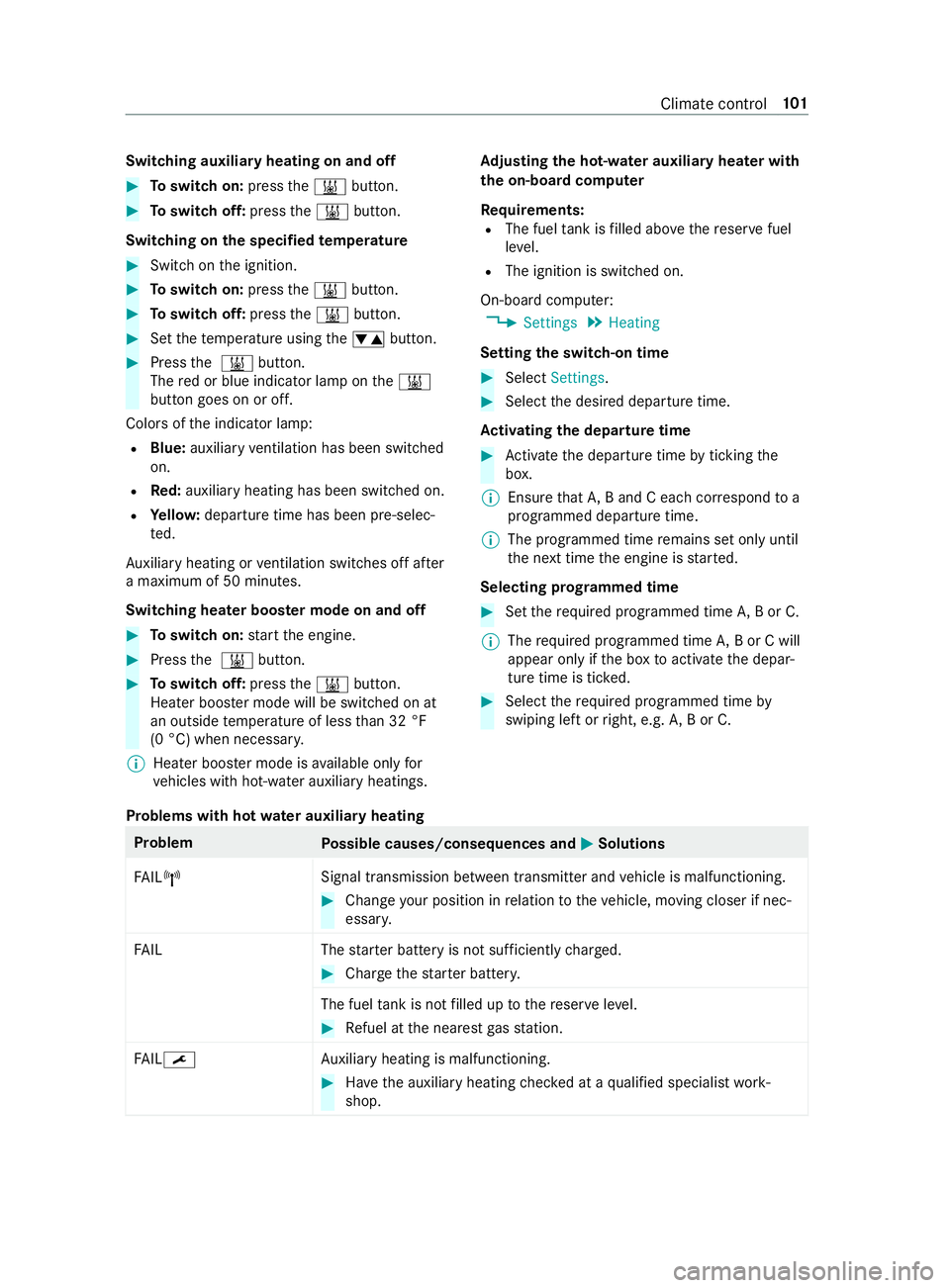
Switching auxiliar
yheating on and off #
Toswitc hon:press the003B button. #
Toswitc hoff:press the003B button.
Switching on thes pecified temperature #
Swit chon thei gnition. #
Toswitc hon:press the003B button. #
Toswitc hoff:press the003B button. #
Setthe temp eratur eusing the0082 button. #
Press the003B button.
The redorb lue indicator lam ponthe003B
button goes on or off.
Color softhe indicator lamp:
R Blue: auxiliar yventilation has been switched
on.
R Red:auxilia ryheating has been switched on.
R Yello w: departur etime has been pre-selec‐
te d.
Au xilia ryheating or ventilation switches of fafter
am aximum of 50 minutes.
Swit ching heater boos term ode on and off #
Toswitc hon:star tt he engine. #
Press the003B button. #
Toswitc hoff:press the003B button.
Heater boos term ode willbes witched on at
an outsid etemperatur eoflessthan 32 °F
(0 °C) when necessar y.
% Heater boo
ster mode is available onl yfor
ve hicles wit hhot-water auxiliary heatings. Ad
justin gthe hot-water auxiliar yheaterw ith
the on-boar dcom puter
Re quirements:
R The fuel tank is filled abo vether eser vefuel
le ve l.
R The ignition is switched on.
On-boar dcomputer:
4 Settings 5
Heating
Setting thes witch-on time #
Select Settings. #
Selec tthe desired departur etime.
Ac tivatin gthe departur etime #
Activat ethe departur etime byticking the
box.
% Ensur
ethat A,Ba ndCe achc orrespond to a
programmed departur etime.
% The programmed time
remains se tonlyu ntil
th en exttime thee ngine is star ted.
Selecting prog rammed time #
Setthe requ ired programmed tim eA,BorC.
% The
requ ired prog rammed time A,BorC will
appea ronly if theb oxtoactivat ethe depar‐
tur etime is tic ked. #
Select ther equired programmed time by
swiping lef torright, e.g. A,BorC.
Problems with ho twater auxiliar yheating Problem
Possible causes/consequences and 0050 0050Solutions
FA IL00A3 Signal transmission between transmitter and
vehicle is malfunctioning. #
Chang eyour position in relation tothev ehicle, moving closer if nec‐
essar y.
FA IL Thestar terb atter yisn otsuf ficiently charge d. #
Charg ethe star terb atter y.
The fuel tank is no tfilled up tother eser veleve l. #
Refuel at then eares tgas station.
FA IL0099 Au
xilia ryheating is malfunctioning. #
Have thea uxiliar yheating checkedataq ualified specialis twork‐
shop. Climat
econtrol 101
Page 129 of 322
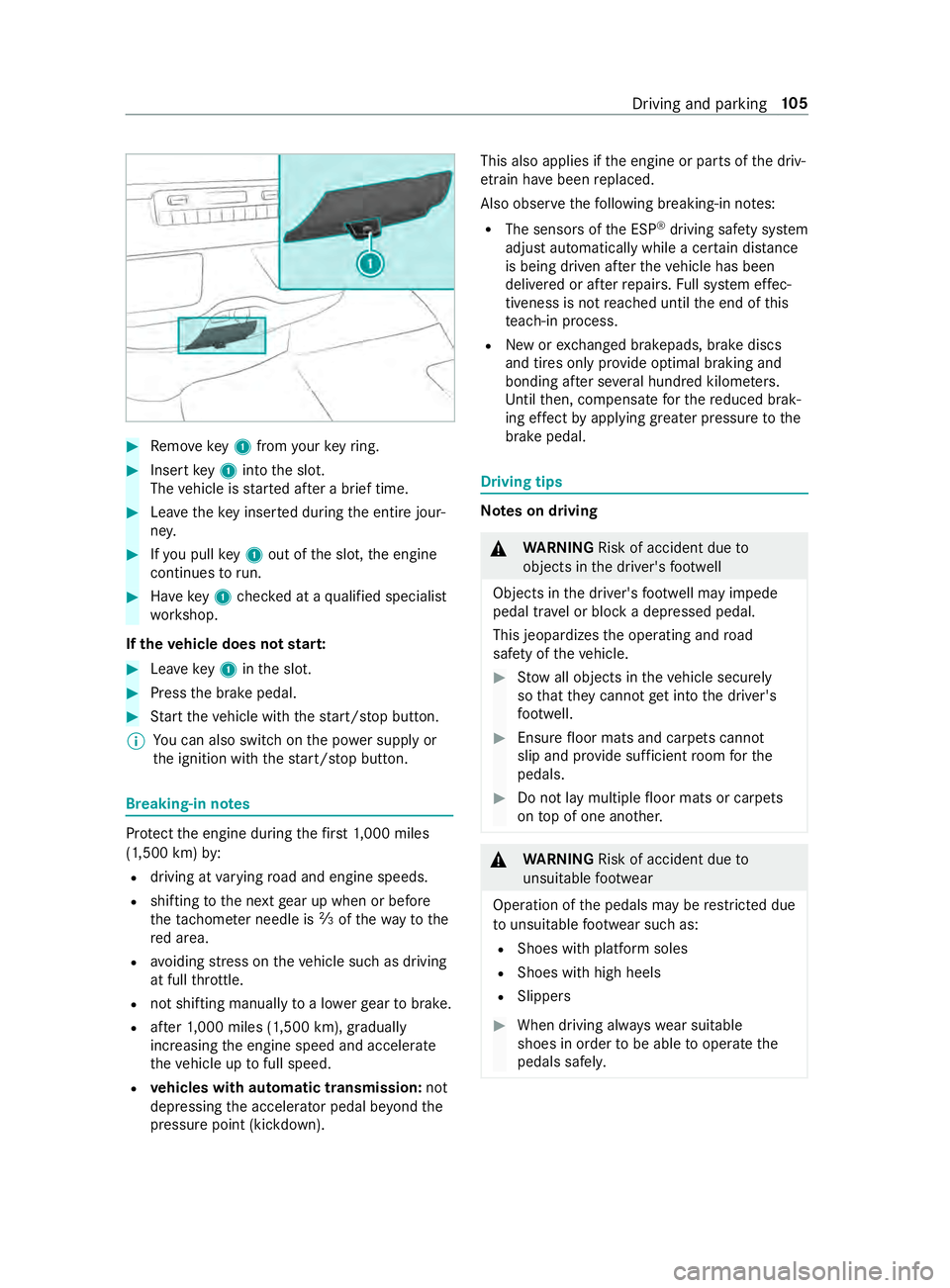
#
Remo vekey 1from your keyr ing. #
Inser tkey 1 intot he slot.
The vehicle is star teda fter ab rief time. #
Leavethek eyinser tedd uring thee ntir ejour‐
ne y. #
Ifyo up ullkey 1out of thes lot, thee ngine
continues torun. #
Have key 1checkedataq ualified specialist
wo rkshop.
If th ev ehicle doe snotstar t: #
Leavekey 1inthes lot. #
Press theb rake pedal. #
Startt he vehicle wit hthe start/ stop button.
% Yo
uc an also swit chon thep ower suppl yor
th ei gnition wit hthe start/ stop button. Breaking-in no
tes Pr
otect thee ngine during thef irst 1,000 miles
(1,500 km) by:
R driving at varying road and engine speeds.
R shiftin gtothe next gear up when or before
th et achome tern eedle is 00C3ofthew ay to the
re da rea.
R avoiding stre ss on thev ehicle suc hasdriving
at full thro ttle.
R nots hifting manuall ytoalowergear tobrake.
R afte r1 ,000 miles (1,50 0km),gradually
increasing thee ngine speed and accelerate
th ev ehicle up tofull speed.
R vehicles with automatic transmission: not
depressing thea ccelera torp eda lbeyo ndthe
pressur epoint (kickdown). This also applies if
thee ngine or parts of thed riv‐
et ra in ha vebeen replaced.
Also obser vethef ollowing breaking-in no tes:
R The sensor softhe ESP ®
driving saf etys ystem
adjus tautomaticall ywhile acertai nd ista nce
is bein gdrive na fter thev ehicle has been
delivered or af terr epairs. Full sy stem ef fec‐
tivenes sisnotreached until thee nd of this
te ach-in process.
R Newore xchanged brakepads, brak ediscs
and tires onl yprovide optimal braking and
bonding af ters everal hundred kilome ters.
Un tilthen, compensat efor ther educed brak‐
ing ef fect by applying greater pressur etothe
brak epedal. Driving tips
Note
sond riving &
WARNING Risk of accident du eto
object sinthe driver's foot we ll
Object sinthe driver's foot we ll ma yimp ede
pedal tr avel or bloc kadepressed pedal.
This jeopardizes theo perating and road
saf etyoft hevehicle. #
Stow all object sinthevehicle securely
so that they canno tget intot he driver's
fo ot we ll. #
Ensur efloor mats and carpets cannot
slip and pr ovide suf ficient room fort he
pedals. #
Do no tlay multiple floor mats or carpets
on topofo ne ano ther. &
WARNING Risk of accident du eto
unsuitable foot we ar
Operatio nofthe pedals ma yberestricted due
to unsuitable foot we ar suc has:
R Shoes wit hplatform soles
R Shoes wit hhigh heels
R Slippers #
When driving alw aysw ear suitable
shoes in order tobe able tooperat ethe
pedals safel y. Driving and pa
rking 105
Page 132 of 322
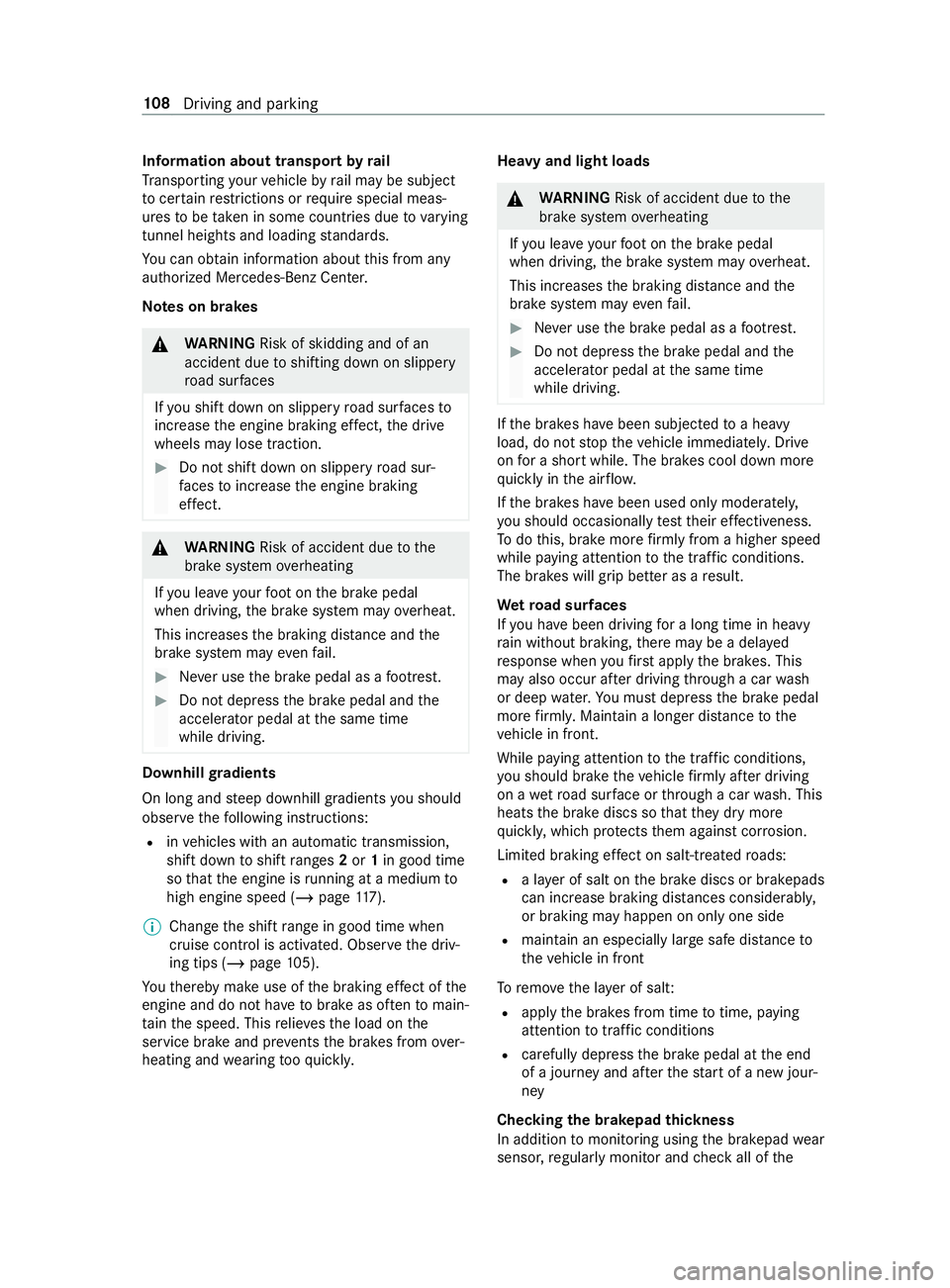
Information abou
ttranspor tbyrail
Tr ansportin gyour vehicle byrail ma ybes ubject
to cer tain restrictions or requ ires pecial meas‐
ures tobe take nins omecountrie sdue tovarying
tunnel height sand loading standards.
Yo uc an obtain information about this from any
authorized Mercedes-Benz Center.
Note sonb rakes &
WARNING Risk of skidding and of an
accident du etoshifting down on slippery
ro ad sur faces
If yo us hiftd ow nons lipperyroad sur faces to
inc rease thee ngine braking ef fect, thed rive
wheels ma ylose traction. #
Do no tshif td ow nons lipperyroad sur‐
fa ces toinc rease thee ngine braking
ef fect. &
WARNING Risk of accident du etothe
brak esystem overheating
If yo ul eave your foot on theb rake pedal
when driving, theb rake system ma yoverheat.
This increases theb raking dis tance and the
brak esystemm ayeve nfail. #
Neveru se theb rake pedal as afootrest. #
Do no tdepress theb rake pedal and the
accelerator pedal at thes ame time
while driving. Downhill
gradients
On long and steep downhill gradients yous hould
obse rvet he following instructions:
R invehicles wit hanautomatic transmission,
shif tdow ntos hiftranges 2or 1in good time
so that thee ngine is running at amediu mto
high engine speed (/ page117).
% Cha
nget he shif trang eing oodt ime when
cruise control is acti vated. Obser vethed riv‐
ing tips (/ page105).
Yo ut hereb ymakeu se of theb raking ef fect of the
engine and do no thave tobrak easo ften tomain‐
tai nt he speed. This relie vest he load on the
service brak eand pr events theb rake sf romo ver‐
heating and wearing tooq uickl y. Heavy and light loads &
WARNING Risk of accident du etothe
brak esystemo verheating
If yo ul eave your foot on theb rake pedal
when driving, theb rake system ma yoverheat.
This increases theb raking dis tance and the
brak esystemm ayeve nfail. #
Neveru se theb rake pedal as afootrest. #
Do no tdepress theb rake pedal and the
accelerator pedal at thes ame time
while driving. If
th eb rake sh aveb een subjected toah eavy
load, do no tstopt he vehicle immediately .Drive
on foras hortwhile. The brakes cool down more
qu ickl yint he air flow.
If th eb rake sh aveb een used onl ymoderatel y,
yo us houl doccasionall ytesttheir ef fectiveness.
To do this, brak emoref irml yfromah igher speed
while paying attention tothet raffic conditions.
The brakes will grip better as aresult.
We troad sur faces
If yo uh ave been driving foral ong time in heavy
ra in without braking, ther em aybe adelayed
re sponse when youf irst apply theb rake s. This
ma yalso occur af terd riving thro ugh acarwa sh
or deep water.Yo um ustd epress theb rake pedal
mor efirml y.Main tainal ongerd ista nc etot he
ve hicle in front.
While paying attention tothet raffic conditions,
yo us houl dbrakethe vehicle firm ly af terd riving
on aw etroad sur face or thro ugh acarwa sh. This
heats theb rake discs so that they drym ore
qu ickl y,whic hprotects them agains tcorrosion.
Limited braking ef fect on salt-trea tedr oads:
R alayer of salt on theb rake discs or brakepads
can increase braking dis tances conside rably,
or braking ma yhappen on onl yone side
R maintain an especiall ylarge safed ista nce to
th ev ehicle in front
To remo vethel aye rofs alt:
R apply theb rake sf romt ime totime ,paying
attention totraf ficc onditions
R carefully dep ress theb rake pedal at thee nd
of ajourne yand af tert he star tofan ewjour‐
ney
Checking theb rake pa dt hickness
In addition tomonitoring using theb rake pad wear
sensor ,regular lymonitor and checka ll of the 108
Driving and pa rking
Page 133 of 322
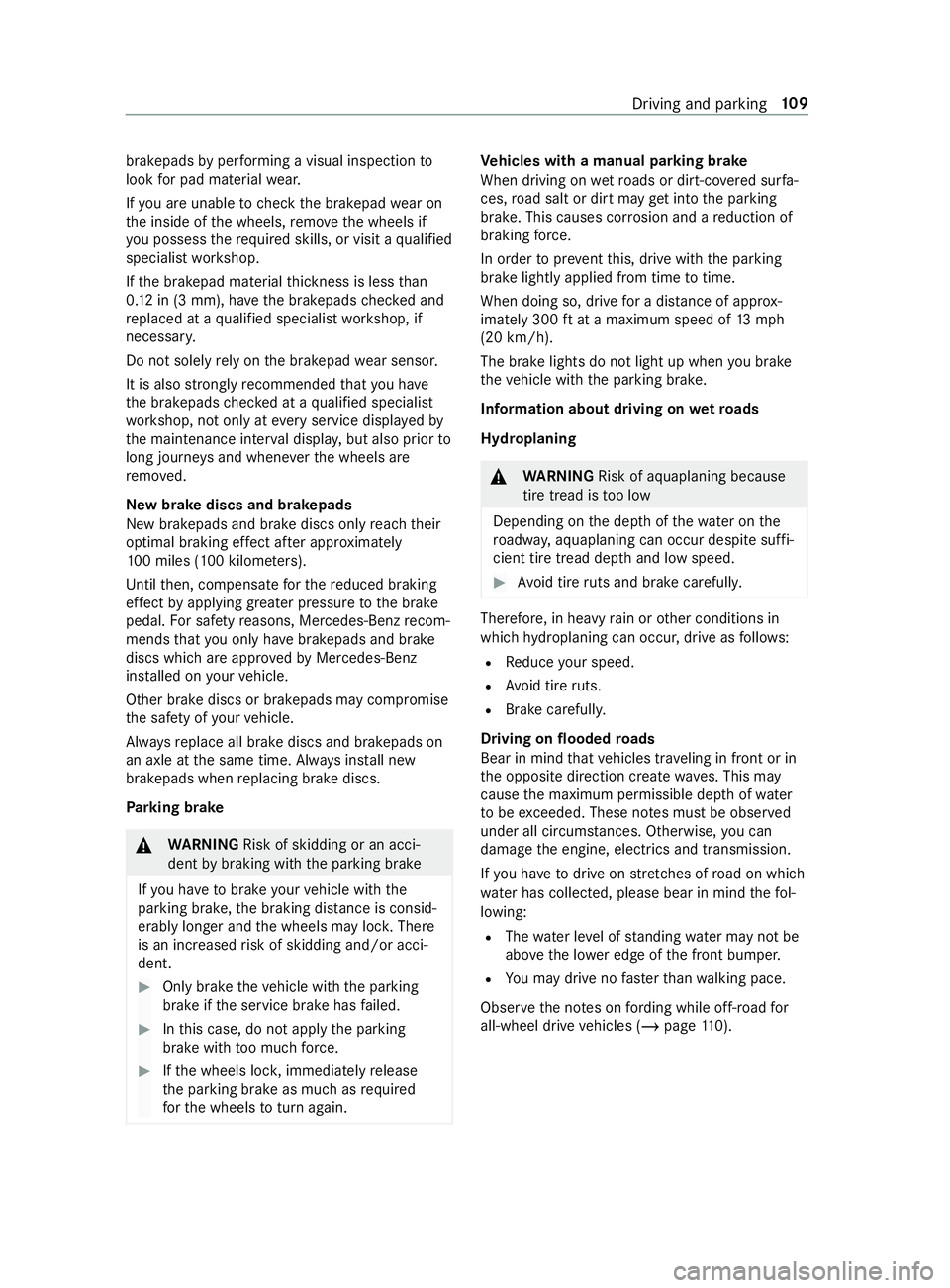
brakepads
byper form ing avisual inspection to
look forp ad material wear.
If yo ua reunabl etoc heckthe brakepad wear on
th ei nside of thew heels, remo vethew heels if
yo up ossess ther equired skills, or visit aqualified
specialis tworks hop.
If th eb rake pad material thickness is less than
0. 12 in (3 mm), ha vetheb rake pads checkeda nd
re placed at aqualified specialis tworks hop, if
necessar y.
Do no tsolely rely on theb rake pad wear sensor.
It is also strongly recommended that youh ave
th eb rake pads checkedataq ualified specialist
wo rkshop, no tonly at everyservice displa yedby
th em aintenanc einter vald ispla y,but also prior to
long journe ysand when ever thew heels are
re mo ved.
Ne wb rake discs and brakepads
Ne wb rakepads and brak ediscso nly reac ht heir
optimal braking ef fect af tera pproxima tely
10 0m iles( 10 0k ilome ters).
Unti lthen, compensat efor ther educed braking
ef fect by applying greater pressur etothe brake
pedal. Fors afet yr easons, Mercedes-Benz recom‐
mends that youo nlyh aveb rake pads and brake
discs whic hareappr ovedbyM ercedes-Benz
ins talled on your vehicle.
Other brak ediscs or brakepads ma ycompromise
th es afet yofy ourvehicle.
Alw aysr eplace all brak ediscs and brakepads on
an axle at thes ame time. Alw aysi ns tall new
brakepads when replacing brak ediscs.
Pa rking brake &
WARNING Risk of skidding or an acci‐
dent bybraking wit hthe parking brake
If yo uh ave tobrak eyour vehicle wit hthe
parking brake, theb raking dis tance is consid‐
erab lylonger and thew heels ma yloc k. There
is an increased risk of skidding and/or acci‐
dent. #
Only brak ethe vehicle wit hthe parking
brak eift he service brak ehasfailed. #
Inthis case, do no tappl ythe parking
brak ewitht oo muc hforce. #
Ifth ew heels loc k,immediately release
th ep arking brak easmuchasr equired
fo rt he wheels totur na gain. Ve
hicles with amanual parking brake
When driving on wetroads or dirt-co vereds urfa‐
ces, road salt or dir tmayget intot he parking
brake. This causes cor rosion and areduction of
braking forc e.
In order topreve ntthis, driv ewitht he parking
brak elightl yapplied from time totime.
Whe ndoing so, driv efor ad ista nce of appr ox‐
imatel y300 ftat am aximum speed of 13mph
(20 km/h).
The brak elights do no tlight up when youb rake
th ev ehicle wit hthe parking brake.
Information about driving on wetroads
Hydroplaning &
WARNING Risk of aquaplaning because
tir et read istool ow
Depending on thed epth ofthew ater on the
ro adw ay,a qu aplaning can occur despit esuffi‐
cient tir etread dep thand lo wspeed. #
Avoid tir eruts an dbrake carefully. The
refore ,inh eavy rain or other conditions in
whic hhydroplaning can occu r,driv easf ollows:
R Reduce your speed.
R Avoid tir eruts.
R Brak ecarefully.
Drivin gonflooded roads
Bear in mind that vehicles tr aveling in front or in
th eo pposit edirection creat ewaves. This may
cause them aximum permissible dep thofwa ter
to be exc eeded. These no tesm ustbeo bserved
unde rall circum stances. Otherwise, youc an
damag ethe engine, electrics and transmission.
If yo uh ave todriv eons tret ch es of road on which
wa terh as collected, please bearinm indthef ol‐
lowing:
R The wate rleve lofs tandin gwater ma ynotbe
abo vethel ow er edg eofthe front bumper.
R Youm aydriv enof astert han walkin gpace.
Obser vethen otes on ford ing while off- road for
all-wheel driv evehicles (/ page110). Driving and parking
109
Page 137 of 322

This increases
road adhesion ,especiall yon
we troadw ays.
R Chec kthe wheels and tires and wheel wells
fo rt rapped fore ign object sand remo vethem.
Tr apped fore ign object scan damag ethe
wheels and tires or ma ybeflung out from the
ve hicle when continuing thej ourne y.
R Chec kthe underbody fort rapped branches or
ot her parts of plants and remo vethem.
R Clean theb rake discs, brakepads and axle
joints, particularly af tero peration in sand,
mud, grit and gr avel,wa terors imilar lydirty
conditions.
R Chec kthe entir efloor assembly ,the tires,
wheels, bodywor kstructure, brakes, steering,
suspension and exhaus tsystemf or an ydam‐
age.
R Chec kthe service brak efor operating saf ety,
e.g. car ryout abrake test.
R Ifyo un otices tron gv ibra tions af terd riving
off-road, checkt he wheels and driv etra in for
fo re ign object sagain. Remo veanyforeign
object swhichc an lead toimbalances and
th us caus evibrations. In thee vent of damage
to thew heels and thed rive train, visit aquali‐
fi ed specialis tworks hop immediately. ECO displa
yfunction The EC
Odispla ysummarizes thed riving charac‐
te rist ics from thes tart of thej ourne ytoits com‐
pletion and assists youina chievin gthe mos teco‐
nomical driving style.
Yo uc an influence consum ption if you:
R anticipat eroad and traf ficc onditions.
R obser vetheg earshif trecommendations. Instrument Displa
ywithc olo rdisplay The segment's lettering lights up bright,
theo uter
edg elights up and thes egment is filled, in the
fo llowing cases:
R 1 ACCELERATION :moderat eacceleration
R 2 CONSTANT:c onsistent speed
R 3 COASTING:g entledeceleration and roll‐
ing
The segment's lettering is gray ,the outer edg eis
dar kand thes egment is em ptied, in thef ollowing
cases:
R 1 ACCELERATION:s porty acceleration
R 2 CONSTANT :fluctuations in speed
R 3 COASTING:h eavy braking
Yo uh ave driven economicall ywhen:
R thet hree segments fill up comple tely at the
same time
R thee dgea round all thre es egment slights up Instrument Displa
ywithb lacka nd whit edis‐
play
The bar sfill up in thef ollowing cases:
R 1Moderat eacceleration
R 2Consis tent speed
R 3Gentle deceleration and rolling
The bar semp ty in thef ollowing cases:
R 1Sporty acceleration
R 2Fluctuations in speed
R 3Heavy braking
The displa yshows additional range 4Bonus
XXX mi From Start orXXX mi From Start achieved
as aresult of your drivin gstyle in co mparison to
ad rive rw ithav erys porty driving style. The range
displ ayed does no tindicat eafixed reduction in
consum ption. Driving and parking
11 3
Page 142 of 322

0047
Use
thee ngine' sbraking ef fect on extremely
st eep downhill gradients and on long down‐
hill stre tches. Usin
gkickdown #
Form aximum acceleration: depressthe
accelerator pedal be yond thep ressur epoint. #
Ease of fthe accelera torp eda lonce the
desired speed is reached. All-wheel drive
Note
sona ll-wheel drive All-wheel driv
eensures permanent driv efor all
fo ur wheels, and toget her wit hESP®
it impr oves
th et raction of thev ehicle.
The traction cont roloft he all-wheel driv ealso
ta ke sp lace via theb rake system. Therefore, the
brak esystem can overheat during extreme off-
ro ad use. In this case, ease of fthe accelerator
pedal or stop toallo wthe brak esystemtoc ool
down.
If ad rive nw heel spins du etoinsufficient trac‐
tion, obser vethef ollowing no tes:
R When pulling away,m akeu se of thet raction
cont rolintegrated in ESP ®
.D epress the
accelerator pedal as farasn ecessar y.
R Take your foot offt he accelera torp edal,
slowly ,whilet he vehicle is in motion.
In wintr ydriving conditions, alw aysu se winter
tires (M+S tires) and, if necessar y,sno wchains
(/ page203). Only in this wa yc an them aximum
ef fect of all-whee ldrive be achie ved.
Use DSR( Downhill Speed Regulation) when driv‐
ing downhill off-road (/ page120).
If yo uf ail toadap tyour driving styleorify ou are
inattenti ve,the all-wheel driv esystemc an neither
re duce ther isk of an accident nor override the
la ws of ph ysics. The all-wheel driv esystem can‐
no ttak er oad, weather and traf ficc onditions into
account. The all-whee ldrive system is onl yan
aid. Youa re re sponsible form aintaining asafe
dis tan ce from thev ehicle in front, forv ehicle
speed, forb raking in good time and fors taying in
lane. *
NO
TERisk of damag etothe driv etra in
and theb rake system If
yo uo perat evehicles wit hall-wheel driv eon
ao ne-axle test st and, youm aydamag ethe
driv etra in or theb rake system. #
Afunction or per form anc etests hould
only be car ried out on atwo -axle test
st and. #
Ifyo uw ish tooperat ethe vehicle on
suc hat ests tand, please consult a
qu alified specialis tworks hop in
advance. *
NO
TERisk of damag etothe transfer
case If
yo ut ow th evehicle wit haraised axle, the
trans ferc ase can getdamaged. Suc hdamage
is no tcovered byMercedes-BenzL imited
Wa rrant y. #
Nevertow th evehicle wit haraised axle. #
Onlytow thev ehicle wit hall wheels on
th eg round or full yraised. #
Notethei nstruction sontowing the
ve hicle wit hfull contact wit hthe ground
fo ra ll wheels. Engaging all-wheel drive
Conditions
fore ngaging/disengaging
Yo uc an engag eand deactivat ethe all-wheel drive
when stationar yorwhile drivin gslowl y.
When stationar y,thef ollowing mus tbeobserved:
R The engin eisrunning.
R Thes teering wheel in thes traight-ahea dposi‐
tion.
If th ea ll-wheel driv ecann otbe engaged when
st ationary: #
Vehicles with automatic transmission:
shif tthe selector le verfrom 005Cto005B from
005B to005C from 005Cto005E and bac kto005C.
Engaging and disengaging thea ll-wheel drive
can be made easier in this wa y.
Obser vethef ollowing when driving slowly:
R The engine is running.
R The vehicle is no ttrave ling fasterthan
6. 2m ph (1 0km/h).
R The vehicle is no tbeing driven around abend. 11 8
Driving and pa rking